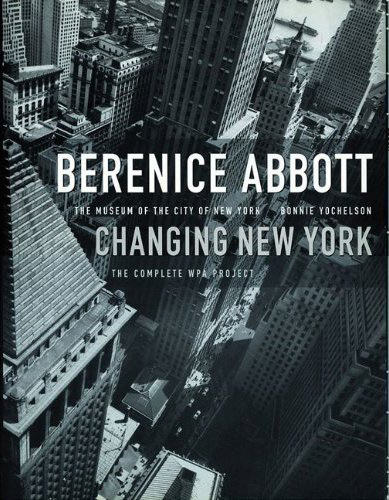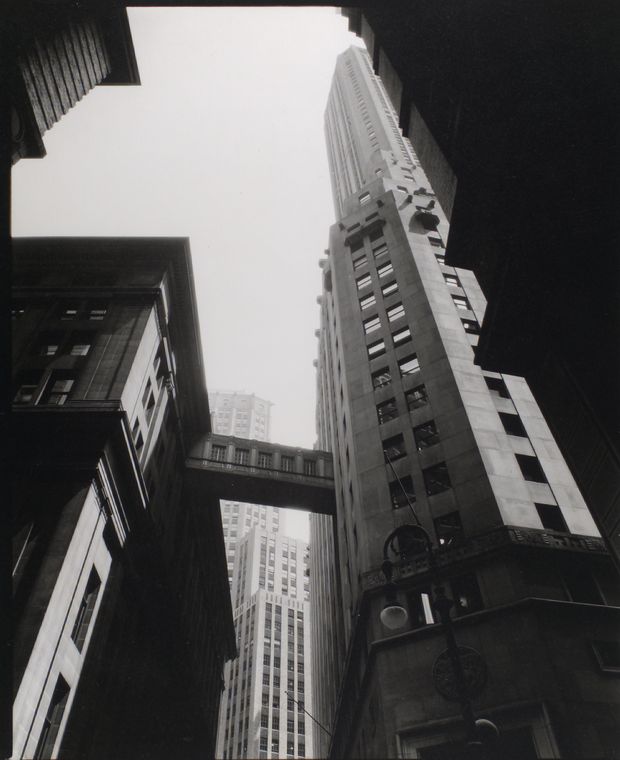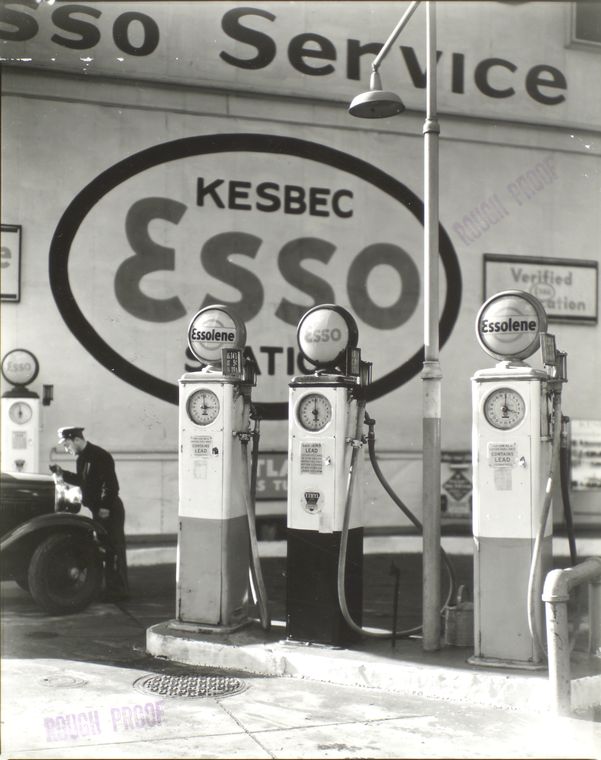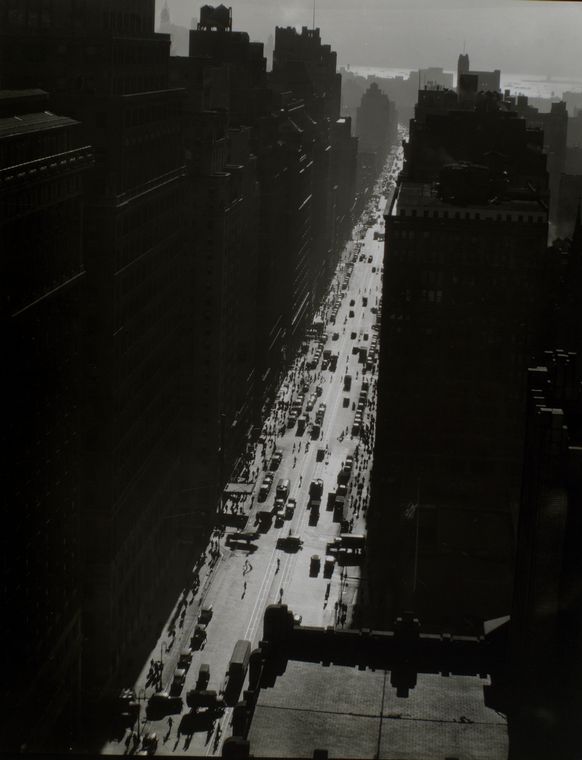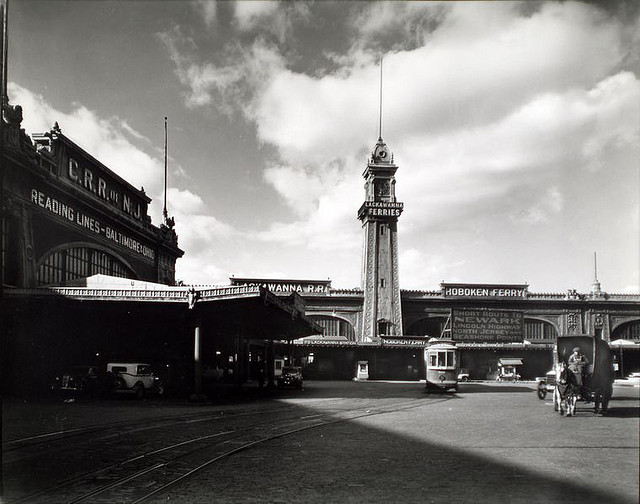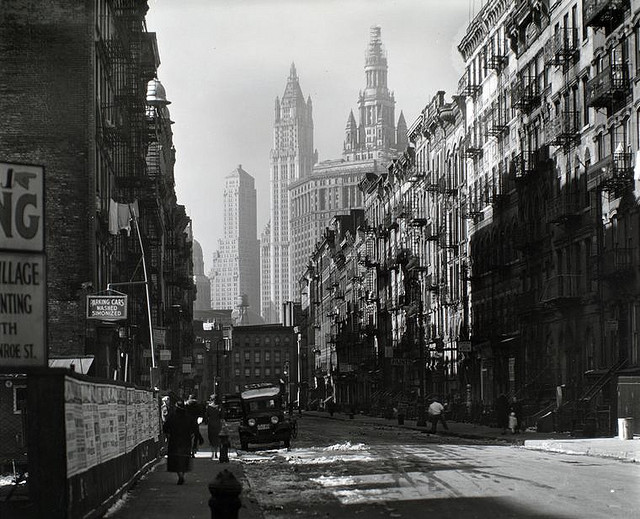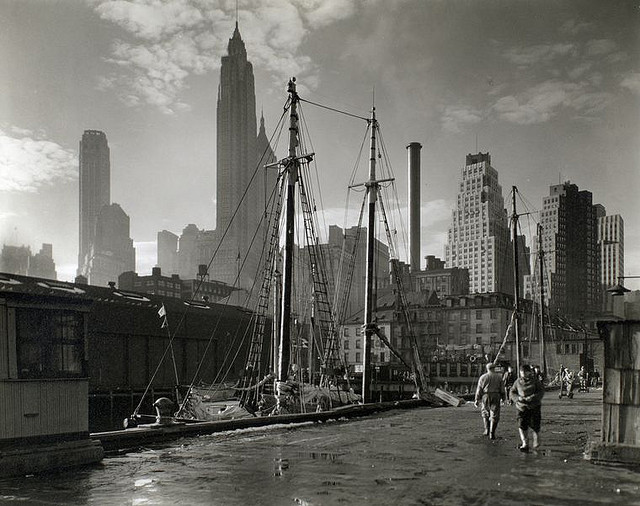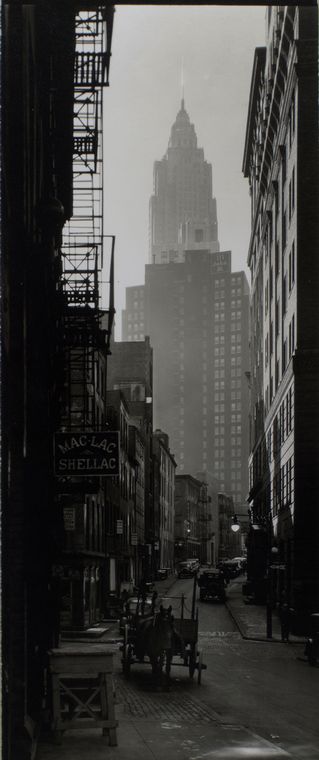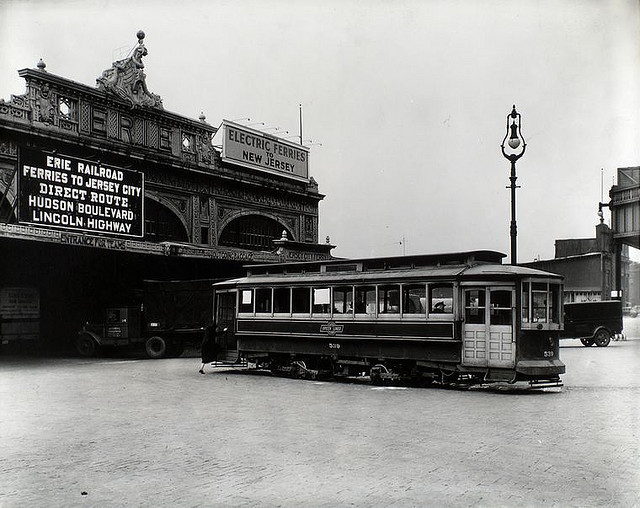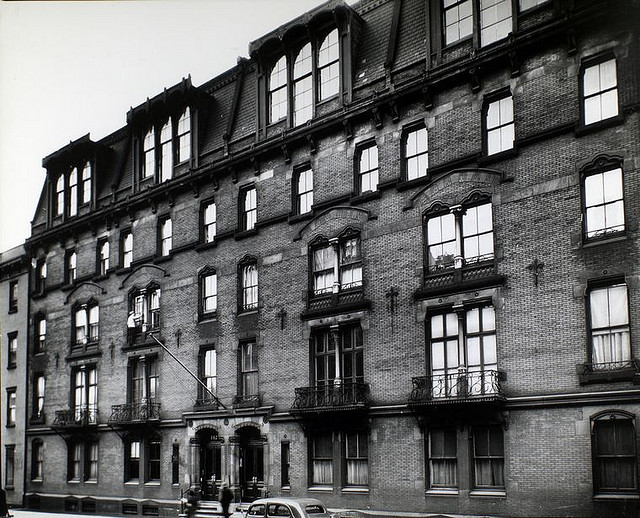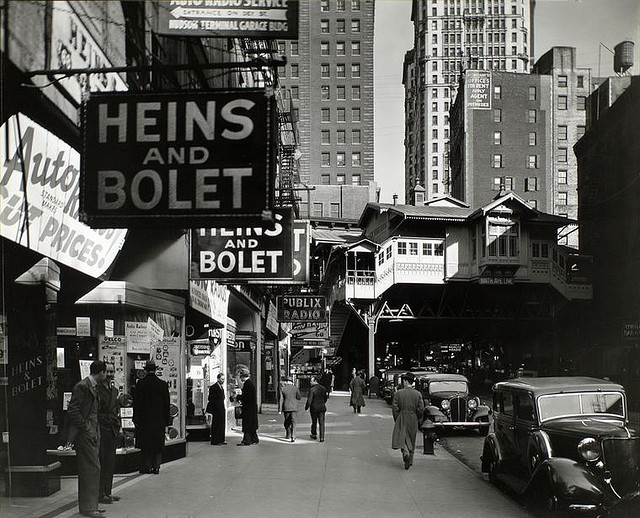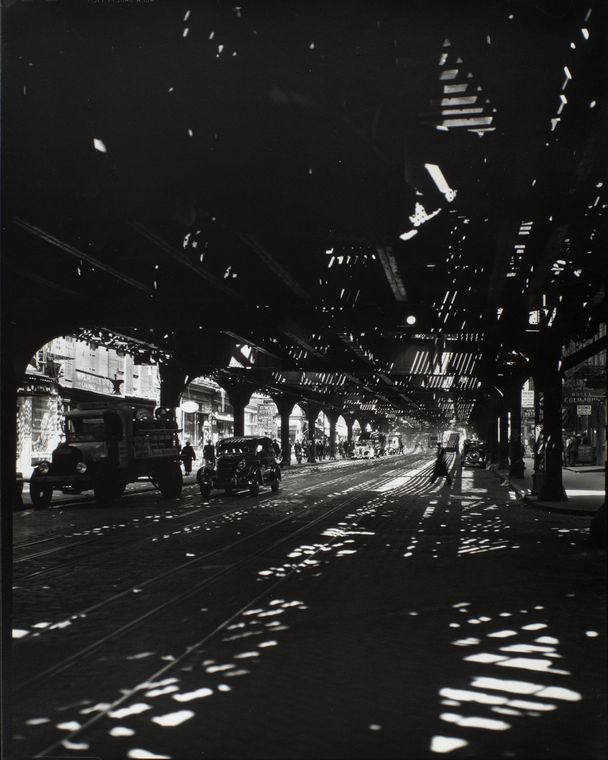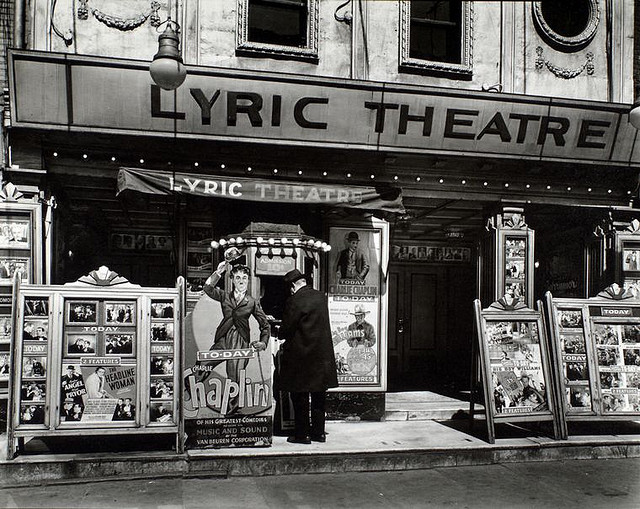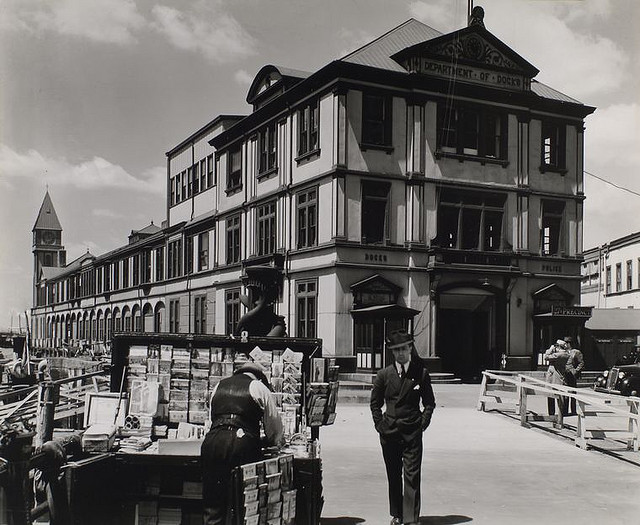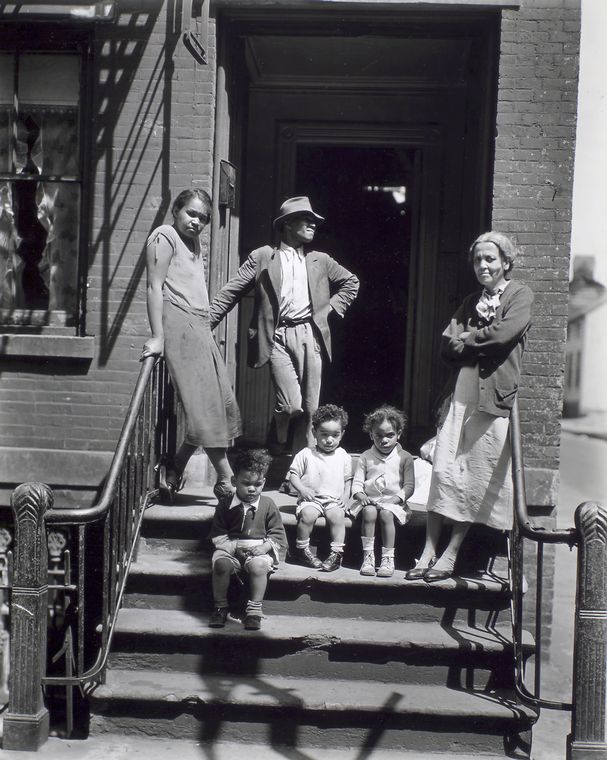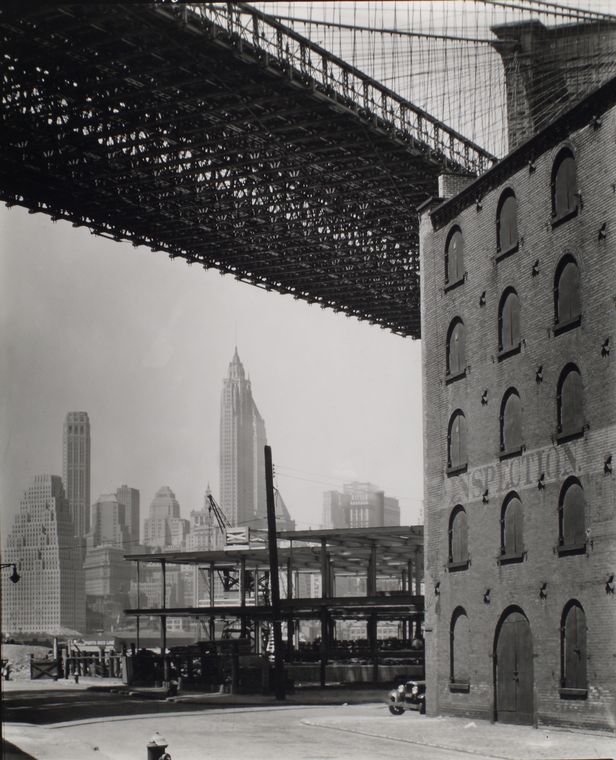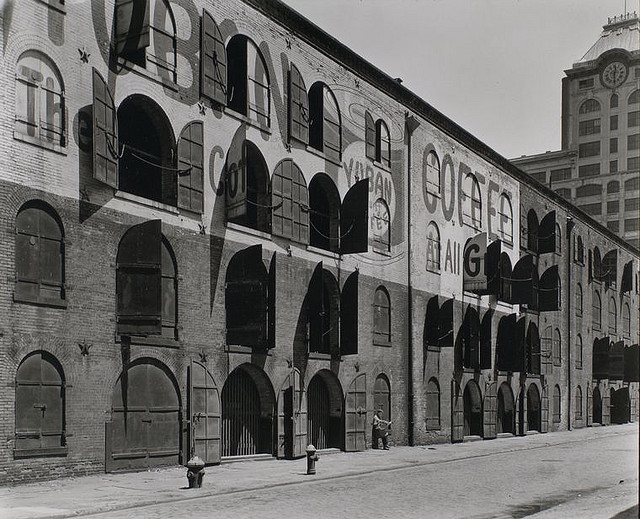The compositional element of your still life work is an absolutely crucial part of ensuring that your work is engaging and unique. Consider the rule of thirds, how can that be applied to your shoot to create a strong composition. Ensure there are no distractions within the frame, just the subject and the backdrop.
Be sure to vary the composition of the subject matter through the shoot and think outside the box. Where are you leading the eye within the image? Are you utilizing negative space or might it work to try and fill the frame? Engage with the subject, what are its defining features? What is it used for? Are you able to put it into context or does it work as a stand alone subject?
 |
© JOEL MEYEROWITZ
A scene capturing the energy of a New York City street. Joel Meyerowitz explains in his book: "I was trying to unlock photography from the esthetic of 'the decisive moment'--a difficult thing to give up." To see more images, click on the Photo Gallery link below.
|
Photographer Joel Meyerowitz recently released a 50-year retrospective monograph of his work called Taking My Time. The two-volume set, published by Phaidon, showcases his wide-ranging oeuvre. Starting with his formative 35mm street photography dating back to 1962, the book includes various projects that he shot over the past few decades, mostly with a large-format view camera, on Cape Cod, Massachusetts, and in St. Louis, Europe and his hometown, New York City. In November, PDN Executive Editor David Walker visited Meyerowitz at his studio, where he talked about the book, and the inspirations and experimentations that shaped his work and career. You can read Part II of our Q&A with Meyerowitz here. (Check PDNOnline later in the week to hear audio excerpts from the interview.)
PDN: Going through all of your archives, were there things you discovered about yourself that you hadn’t realized until you started putting this book together?
Joel Meyerowitz: Part of the pleasure of making a book like this is going back through the work and recognizing aspects of bodies of work that project themselves forward a number of years—where you didn’t quite understand that that’s where your work was headed. Once you have the advantage of looking back from this moment in time, it all seems to line up. So I could see that I had instincts back in the 1960s to do certain kinds of things that didn’t play out until a few years later.
There’s a quote from Robert Frost in a wonderful essay that I love, called “The Figure a Poem Makes.” He says something to the effect of: We’re like giants, hurling our experiences ahead of us, like stones. And that’s so true for photography. Every time you take a picture, it’s a moment in your present that is of a certain immediacy and necessity. And you accept it, you say yes to it, but you don’t know how to integrate it.
PDN: We’re talking about intuition here and your comfort with it.
JM: I think what differentiates artists from each other [is] the degree to which they trust their intuition and shape it. As it shapes them, they shape it. Because if you don’t trust your instinct, you won’t survive.
PDN: Was there a particular point, or maybe even a particular image, where you realized that something clicked? That you had found your own voice?
JM: Yeah, yeah. The earliest pictures were bull’s-eye pictures: something in the center of a frame, right? You shoot at it. Huh! I got it. You learn how to get a frame around an object. But objects, after a while, aren’t enough. Because it’s almost like pointing your finger: See the guy with the dog? See the baby? See the sunset? So you ask yourself: What else is there to see? And I saw in that first year that there was a way of making a picture about the relationship between things.
PDN: Which picture was it?
JM: [There’s] a girl in [a] window and she’s holding onto a window ledge in the background and she’s crying or yelling, and then on the street in front of her a parade must be going by because there are some parade barriers … I could see these people clustered near to me looking in all different directions and I could see the girl in the window screaming and there were people on her steps. So the picture was filled with stuff all over it. And I thought: Oh, it’s a photograph! Because the temptation would be to run as close to the girl as possible and take a picture of this screaming, in-distress little girl in the window. And instead, I held my ground and took a picture of the entirety of the space.
The recognition of that was like a release. Suddenly, you thought: Oh, there are other options for making pictures. I think that that developmental recognition is part of the way you lift yourself up by your own bootstraps. You suddenly think: Oh, there’s more to this than shooting the arrow into the bull’s-eye. And I think with each succeeding phase of my inquiry about photography, I’ve had to let something go in order to try on a new, riskier way of looking at something.
PDN: I wonder if you can talk a little bit about your switch to color and how it changed the way you shoot.
JM: Well, I was shooting color all along. I was using two cameras to try to take the same photograph so that I could analyze the difference between color and black-and-white. I saw it as a problem that photography was negating the use of color because “art” was black-and-white. Color was for amateurs. I thought: Fuck that, I don’t believe it. The whole world is in color, and it should be in color, and I’m going to stand up for this medium. I had been moving in that direction all along. In the early 1970s, John Szarkowski [then director of photography at the Museum of Modern Art in New York City] had written a book called Looking at Photographs. His theme was: All a camera does, it describes what’s in front of the camera when you press the button. I thought: If description is what it’s all about, black-and-white description is half of what color description is. So I thought: I’m going to try to take this to that level.
Before I had the Guggenheim show, around 1972, I stopped shooting black-and-white. But once you start working only in color, you want to have description, [and] to me on the street, description was everything. From five feet in front of me, to the buildings on 59th Street, I wanted everything there to be rendered as exquisitely as Kodachrome could do it. Because in black-and-white, you rack the ASA up to 1,000 and you have everything in focus. With Kodachrome, the ASA was 25. That meant you had no depth of field. So if you wanted description that a color slide could give you, you had to find a strategy that gave you a greater depth of field. For me that meant stepping back from the plane that I normally would work in.
PDN: This was an example of leaving behind what you were accomplished and good at to take a risk on something unknown?
JM: It was a trade-off. If I wanted to have this [description]… of the entirety of the street, I needed to step back enough to get all that fullness, and by stepping back, the event, or the incident between two people or two sets of people, became further away. Many of my friends at that time were looking at the photographs I was showing and saying, “Oh, you’ve lost your touch.” Because “the touch” was to be closer and to catch those incredible moments when somebody did something. I thought: No, I have that touch—but I want to go beyond that and so I have to go dumb, in a way, to learn what is it that is possible to photograph in New York City right now that doesn’t concern itself merely with an incident.
PDN: Is [“Camel Coats, 5th Avenue, New York City, 1975”] with the pedestrians in the camel hair coats an example?
JM: That is. The space, the obscured space of the steam, the deep space of the sky and the architecture behind it, the people in the shadows on the side of the street—it all enhances what looks like a kind of coincidence and mystery at the same time … That distance was where I was working at. There are a lot of other pictures in the book that are fragmentary that way. I kept on thinking of them as nonhierarchical. Because any picture that has something in [it] that you immediately go to sets up a hierarchy: Here is the first stage of the picture … I wanted to try to make a field photograph, not unlike the field paintings that were going on then in which everything in the painting was what the painting was about—not a [single] gesture in it.
PDN: What made you move on to the view camera?
JM: I continued making [pictures] with 35mm, but what I wanted [was] a greater degree of description because when I started making these new kinds of pictures, I started making large dye transfers. They showed everything, to the degree that I thought: I want these even bigger; I want these wall size. But I couldn’t print bigger than [11 x 14 inches] because it was far too expensive to make a dye transfer. I thought: I’ve got to get myself a camera where I can shoot color negative film, so I can print. I had a darkroom here by that time. I tried other cameras: medium-format cameras and medium-format films and everything. They were too slow to work on the street, and I kept on thinking to myself: Shit, if I have to use a tripod—I don’t want to use a tripod, I’m a street photographer—but if I have to use a tripod, I might as well get an 11 x 14 camera, if I’m going to do this. So I went looking for an 11 x 14 camera, and I only found an 8 x 10, so I bought it. I still use that camera. And I decided: I’m making this leap in the name of description.
PDN: Talk about how this changed the way you photograph people.
JM: On the street, the game is to be invisible, so that you can be as close to people as you wish, and they don’t know you’re taking the picture. Much easier back in the 1960s and ’70s when people didn’t have the idea of their 15 minutes of fame, or of the Internet, onto which you are going to spread their picture, and steal their souls. However, when I was walking around with an 8 x 10 view camera on 6-foot tall tripod legs with a big black cloth hanging on it, people would see me, and they would ask, “What are you doing? What’s that? Why the wooden box?” Before you know it, you’re talking to strangers.
What I did notice was that when I would speak to them, they were fantastic. You looked at their faces, their hair, their breasts, their shorts, the way their clothes fit them. Everything about them became like a landscape—a human landscape. And so I found myself saying to people, “Ah, you know what? Let me take your portrait right now,” and learning: How do you make a portrait? … It’s a picture of you and them, to some degree.
When you focus on them and you come out from the dark cloth and you put the film in, you step aside, and you’re standing alongside the camera with your shutter release, and they are looking in the camera, not at you. There’s no longer any kind of game and you are basically saying to them, “It’s just you and the camera now. I want you to be as open and true to yourself as you possibly can be right now. And I will watch. And when I see you appear, I’ll take the picture.” These people can reveal something hidden about [themselves] and that moment is transcendent.
PDN: There’s a commonality between your athletic street photography and recognizing an instant when that personality in a portrait appears.
JM: It’s exactly right, and I’m fortunate that I started on the street. I said that at the very beginning of this [interview]: By starting on the street, I had to learn about human nature. So I recognize … when something is a revelation. You pounce on that—with the shutter—as fast as you can. Even if it’s a long exposure, like a half a second, it’s that moment that you open up and you welcome it in. I earned it on the streets.
PDN: Going through all of your archives, were there things you discovered about yourself that you hadn’t realized until you started putting this book together?
Joel Meyerowitz: Part of the pleasure of making a book like this is going back through the work and recognizing aspects of bodies of work that project themselves forward a number of years—where you didn’t quite understand that that’s where your work was headed. Once you have the advantage of looking back from this moment in time, it all seems to line up. So I could see that I had instincts back in the 1960s to do certain kinds of things that didn’t play out until a few years later.
There’s a quote from Robert Frost in a wonderful essay that I love, called “The Figure a Poem Makes.” He says something to the effect of: We’re like giants, hurling our experiences ahead of us, like stones. And that’s so true for photography. Every time you take a picture, it’s a moment in your present that is of a certain immediacy and necessity. And you accept it, you say yes to it, but you don’t know how to integrate it.
PDN: We’re talking about intuition here and your comfort with it.
JM: I think what differentiates artists from each other [is] the degree to which they trust their intuition and shape it. As it shapes them, they shape it. Because if you don’t trust your instinct, you won’t survive.
PDN: Was there a particular point, or maybe even a particular image, where you realized that something clicked? That you had found your own voice?
JM: Yeah, yeah. The earliest pictures were bull’s-eye pictures: something in the center of a frame, right? You shoot at it. Huh! I got it. You learn how to get a frame around an object. But objects, after a while, aren’t enough. Because it’s almost like pointing your finger: See the guy with the dog? See the baby? See the sunset? So you ask yourself: What else is there to see? And I saw in that first year that there was a way of making a picture about the relationship between things.
PDN: Which picture was it?
JM: [There’s] a girl in [a] window and she’s holding onto a window ledge in the background and she’s crying or yelling, and then on the street in front of her a parade must be going by because there are some parade barriers … I could see these people clustered near to me looking in all different directions and I could see the girl in the window screaming and there were people on her steps. So the picture was filled with stuff all over it. And I thought: Oh, it’s a photograph! Because the temptation would be to run as close to the girl as possible and take a picture of this screaming, in-distress little girl in the window. And instead, I held my ground and took a picture of the entirety of the space.
The recognition of that was like a release. Suddenly, you thought: Oh, there are other options for making pictures. I think that that developmental recognition is part of the way you lift yourself up by your own bootstraps. You suddenly think: Oh, there’s more to this than shooting the arrow into the bull’s-eye. And I think with each succeeding phase of my inquiry about photography, I’ve had to let something go in order to try on a new, riskier way of looking at something.
PDN: I wonder if you can talk a little bit about your switch to color and how it changed the way you shoot.
JM: Well, I was shooting color all along. I was using two cameras to try to take the same photograph so that I could analyze the difference between color and black-and-white. I saw it as a problem that photography was negating the use of color because “art” was black-and-white. Color was for amateurs. I thought: Fuck that, I don’t believe it. The whole world is in color, and it should be in color, and I’m going to stand up for this medium. I had been moving in that direction all along. In the early 1970s, John Szarkowski [then director of photography at the Museum of Modern Art in New York City] had written a book called Looking at Photographs. His theme was: All a camera does, it describes what’s in front of the camera when you press the button. I thought: If description is what it’s all about, black-and-white description is half of what color description is. So I thought: I’m going to try to take this to that level.
Before I had the Guggenheim show, around 1972, I stopped shooting black-and-white. But once you start working only in color, you want to have description, [and] to me on the street, description was everything. From five feet in front of me, to the buildings on 59th Street, I wanted everything there to be rendered as exquisitely as Kodachrome could do it. Because in black-and-white, you rack the ASA up to 1,000 and you have everything in focus. With Kodachrome, the ASA was 25. That meant you had no depth of field. So if you wanted description that a color slide could give you, you had to find a strategy that gave you a greater depth of field. For me that meant stepping back from the plane that I normally would work in.
PDN: This was an example of leaving behind what you were accomplished and good at to take a risk on something unknown?
JM: It was a trade-off. If I wanted to have this [description]… of the entirety of the street, I needed to step back enough to get all that fullness, and by stepping back, the event, or the incident between two people or two sets of people, became further away. Many of my friends at that time were looking at the photographs I was showing and saying, “Oh, you’ve lost your touch.” Because “the touch” was to be closer and to catch those incredible moments when somebody did something. I thought: No, I have that touch—but I want to go beyond that and so I have to go dumb, in a way, to learn what is it that is possible to photograph in New York City right now that doesn’t concern itself merely with an incident.
PDN: Is [“Camel Coats, 5th Avenue, New York City, 1975”] with the pedestrians in the camel hair coats an example?
JM: That is. The space, the obscured space of the steam, the deep space of the sky and the architecture behind it, the people in the shadows on the side of the street—it all enhances what looks like a kind of coincidence and mystery at the same time … That distance was where I was working at. There are a lot of other pictures in the book that are fragmentary that way. I kept on thinking of them as nonhierarchical. Because any picture that has something in [it] that you immediately go to sets up a hierarchy: Here is the first stage of the picture … I wanted to try to make a field photograph, not unlike the field paintings that were going on then in which everything in the painting was what the painting was about—not a [single] gesture in it.
PDN: What made you move on to the view camera?
JM: I continued making [pictures] with 35mm, but what I wanted [was] a greater degree of description because when I started making these new kinds of pictures, I started making large dye transfers. They showed everything, to the degree that I thought: I want these even bigger; I want these wall size. But I couldn’t print bigger than [11 x 14 inches] because it was far too expensive to make a dye transfer. I thought: I’ve got to get myself a camera where I can shoot color negative film, so I can print. I had a darkroom here by that time. I tried other cameras: medium-format cameras and medium-format films and everything. They were too slow to work on the street, and I kept on thinking to myself: Shit, if I have to use a tripod—I don’t want to use a tripod, I’m a street photographer—but if I have to use a tripod, I might as well get an 11 x 14 camera, if I’m going to do this. So I went looking for an 11 x 14 camera, and I only found an 8 x 10, so I bought it. I still use that camera. And I decided: I’m making this leap in the name of description.
PDN: Talk about how this changed the way you photograph people.
JM: On the street, the game is to be invisible, so that you can be as close to people as you wish, and they don’t know you’re taking the picture. Much easier back in the 1960s and ’70s when people didn’t have the idea of their 15 minutes of fame, or of the Internet, onto which you are going to spread their picture, and steal their souls. However, when I was walking around with an 8 x 10 view camera on 6-foot tall tripod legs with a big black cloth hanging on it, people would see me, and they would ask, “What are you doing? What’s that? Why the wooden box?” Before you know it, you’re talking to strangers.
What I did notice was that when I would speak to them, they were fantastic. You looked at their faces, their hair, their breasts, their shorts, the way their clothes fit them. Everything about them became like a landscape—a human landscape. And so I found myself saying to people, “Ah, you know what? Let me take your portrait right now,” and learning: How do you make a portrait? … It’s a picture of you and them, to some degree.
When you focus on them and you come out from the dark cloth and you put the film in, you step aside, and you’re standing alongside the camera with your shutter release, and they are looking in the camera, not at you. There’s no longer any kind of game and you are basically saying to them, “It’s just you and the camera now. I want you to be as open and true to yourself as you possibly can be right now. And I will watch. And when I see you appear, I’ll take the picture.” These people can reveal something hidden about [themselves] and that moment is transcendent.
PDN: There’s a commonality between your athletic street photography and recognizing an instant when that personality in a portrait appears.
JM: It’s exactly right, and I’m fortunate that I started on the street. I said that at the very beginning of this [interview]: By starting on the street, I had to learn about human nature. So I recognize … when something is a revelation. You pounce on that—with the shutter—as fast as you can. Even if it’s a long exposure, like a half a second, it’s that moment that you open up and you welcome it in. I earned it on the streets.
Note: The interview continues in "Joel Meyerowitz on What He's Learned, Part II."
